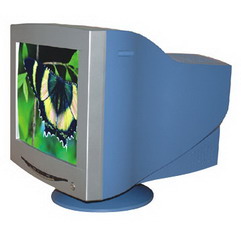CRT monitor
The CRT monitor creates a picture out of many rows or lines of tiny colored dots. The more lines of dots per inch, the higher and clearer the resolution. Therefore 1024 x 768 resolution will be sharper than 800 x 600 resolution because the former uses more lines creating a denser, more detailed picture. Higher resolutions are important for displaying the subtle detail of graphics. For text, resolution isn't as critical.
The CRT monitor comes in 15-inch to 21-inch sizes (38 — 53 cm) and larger, though the actual viewing screen is about 1 inch (2.5 cm) smaller than the rated size. Screens are measured diagonally from corner to corner, including the case.
CRT monitors are cheaper, widely available and are suitable for places where space is not a problem. Negatives of the CRT include radiation emission, high power consumption, weight and bulk.

CRT monitor
Application
They are more suitable where more than one user may need to view screen simultaneously such as in design use, e.g. when several designers may need to offer suggestions on a prototype.
Though CRT monitors still hold a major market share as a display unit for computer but gradually they are becoming outdated and in the near future they will be replaced by TFT/LCD monitors.




